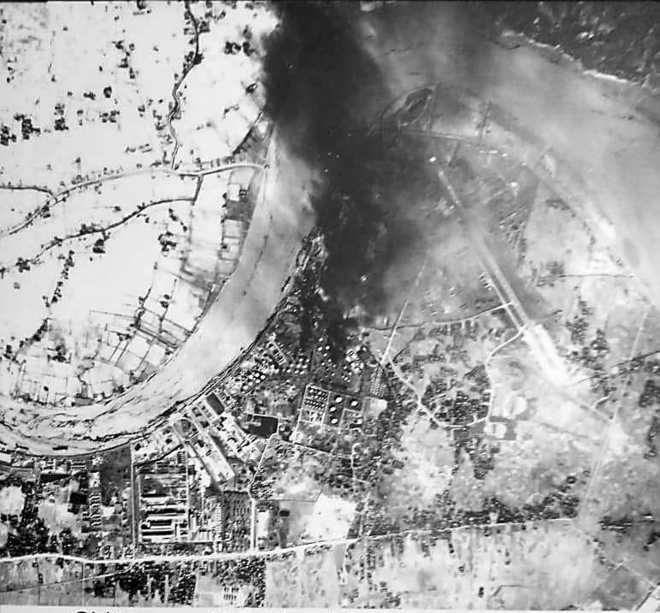
A shot of the Chittagong refinery taken from 10,000 ft above the ground level on 9 December, 1971
Air Commodore Prashant Dikshit (retd)
Air Commodore Prashant Dikshit (retd)
I was fortunate to be one of the crews of No. 106 Strategic Reconnaissance Squadron of the Indian Air Force during the 1971 War with Pakistan. In the annals of the Indian military aviation, the exploits of the squadron largely remained away from the public gaze, primarily due to the secrecy surrounding its activities. It operated the unarmed Canberra PR 7 combat aircraft to gather photo intelligence about strategic targets.
The 1971 War arrived at my door with a bit of a challenge. On December 4, 1971, in the late evening, the Commanding Officer (CO) broke the news that the Bomber Force was looking for one set of crews for a bombing sortie and he wanted volunteers. All of us, including me, raised the right hand, although it was more than three years, let alone flying a bomber, since I had even taken a peek inside it. In routine circumstances, it would have been through a period of refresher orientation, but here only 20 minutes of preflight inspection were available.
The CO had promptly nominated Flt Lt MS Sandhu as the pilot and me as the navigator. We were to drop 8,000 pounds of bombs over the Sargodha airbase in West Pakistan in a midnight raid, which we did accurately and precisely. But the bomb doors would not close after that. This is an emergency condition over enemy territory as it places severe limits on the speed of the aircraft whilst increasing fuel consumption in multiples.
For nearly 15 minutes we endured and, in the course of which, we had to descend into the barrage of anti-aircraft fire. The other choice was to remain high and be a sitting duck for air interception. We climbed eventually in the friendly territory to nearly 45,000 feet to save fuel and get benefits from westerly jet streams. But we lost one engine on the landing run due to no fuel.
For our photo mission on December 8 and 9 in 1971, when we reached the launching airfield in Guwahati, there was hardly any time to refuel. It was critical to reach our first target at Cox Bazaar at 1400 hrs to coincide with the action of the Indian Navy. We entered the mission at the topmost speed which the aircraft could safely withstand to maintain time. The machine guzzles fuel in those flying conditions.
We were to enter East Pakistan at Aizawl from the east to align with our photo run. When we were pulling up for the photo run, there was a potent anti-aircraft fire. We then dived again to the ground quite unmindful of the ground fire and proceeded to Chittagong harbour where a similar photo run had to be executed. Short of the airfield, we climbed through thick smoke billowing from the ships which were perhaps struck a little earlier. Ultimately, we were critically low on fuel.
The photo mission on December 13, 1971 was truly adventurous. We lost a lot of time in rectifying the cause of fire which had erupted in the battery compartment of the aircraft. We were airborne just to be in time to avail of adequate sunlight whilst we covered the Dacca complex. There was great pressure and we were required to proceed directly to Delhi. It was already twilight in Dacca and full darkness as we closed in to Delhi. But, most seriously, our ground speed reduced to 1/3rd compared to what it was during the onward journey to Dacca.
It was one of the most noteworthy experiences of westerly jet streams, which are known to have recorded speed up to 180 Kts (over 300 km/hour) in this terrain-induced wind funnel south of the Himalayas. As a result, we arrived at Palam well beyond the planned flight plan and were declared a hostile aircraft in our own country.
— The writer was awarded the Vayu Sena Medal for gallantry during the 1971 War



























